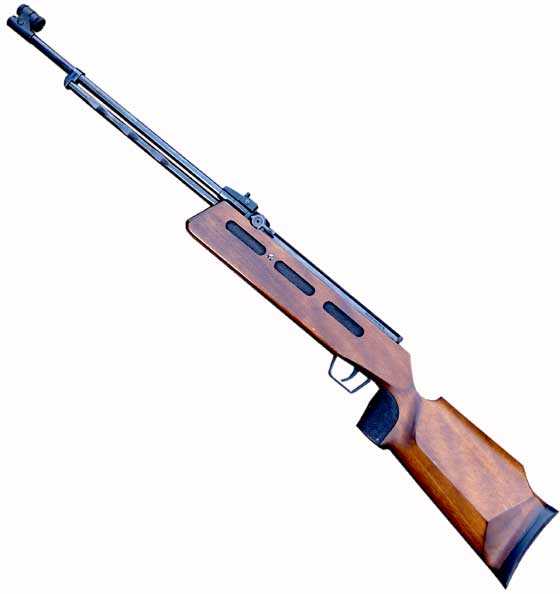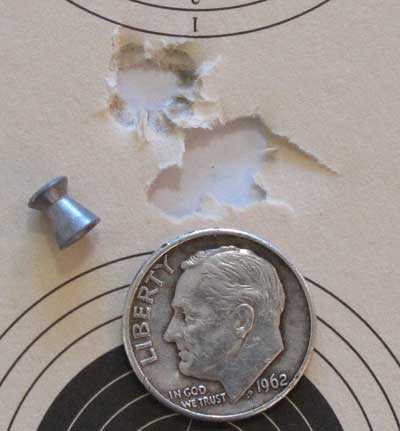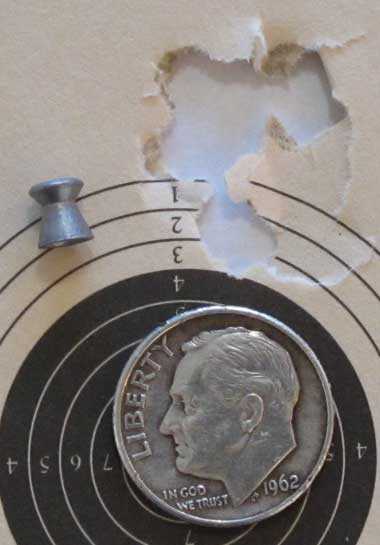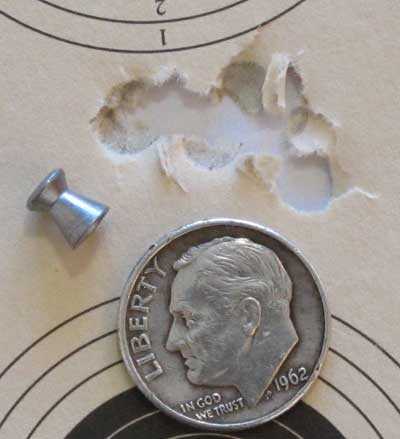by Tom Gaylord
Writing as B.B. Pelletier

Mauser 300SL. There are three finger scallops along the cocking lever.
This report covers:
- Bug Buster
- Trigger adjust
- The test
- Qiang Yuan Training pellets
- JSB Match light weight
- Qiang Yuan Olympic pellets
- Conclusions
I tested the Mauser 300SL target rifle with open sights last time and I wondered if I got everything the rifle had to give. Today I will try to shoot it as accurately as I can. The original plan was to install the best peep sight and front sight element I could find, but that plan didn’t work out. The front sight on the Mauser doesn’t fit any of the target inserts I own, so I can’t change the post and bead that’s there. Without a target element up front, no peep sight will make any difference. I have already tested these sights to their limits.
Bug Buster
I decided to install a UTG 3-9X32 Bug Buster scope instead. Running it at 9 power, nobody can say I didn’t give the 300SL every chance to show its best. I discovered some considerable droop in the barrel when this scope was installed, so I took measures to correct it. As a result, all my groups landed high on the target. Normally I like to zero a target rifle better than you see here, but this one was too much trouble.
Trigger adjust
Just to see what affect they had, I adjusted the two screws in the trigger. As I thought, they affect the length of stage one and the location of stage two. If that sounds like it’s the same thing, it can be. But the screws had been adjusted to remove stage two entirely, which on this trigger made stage one a long and confusing pull with lots of creep. I adjusted them so stage one was not as long. The creep remained in the stage one pull, because the trigger is so crude. But the trigger blade then stopped at stage two, which now breaks relatively crisply. When I say relatively, I mean compared to the vague way the trigger broke before. It’s still way heavier than I like for a target trigger, but it will have to do. I can’t disassemble this trigger to smooth the parts because I would have to destroy the fasteners that hold the pins in place and I don’t know where to get replacements.
The test
Like I did in the last test, I shot off a sandbag rest at 10 meters. The rifle was rested directly on the bag, which didn’t seem to cause any problems with pellets scattering.
Qiang Yuan Training pellets
The best pellet in the last test was the Chinese Qiang Yuan Training pellet, so that was the one I selected to start this test. With open sights I put 10 of these pellets into a group that measures 0.658-inches at 10 meters. With the scope, my 10-shot group measures 0.522. That’s more than a tenth of an inch smaller and is significant, but it’s still in the same ballpark as the group shot with open sights.

Ten Qiang Yuan training pellets went into 0.522-inches at 10 meters when the rifle was scoped. It’s significantly better than the open-sight group, but still in the same size range.
JSB Match light weight
Now it was time to try some different pellets. I shot some JSB Match light weight pellets next. I linked to middle weight match pellets instead, because the light weight pellets are out of stock. JSB calls most of their pellets match pellets, but only the wadcutter shape is allowed in 10-meter matches. They are either referring to other types of competition like field target, or they are using the term match loosely.
Ten of these went into 0.527-inches at 10 meters. That’s so close to the Chinese training pellets that it’s really too close to call. The difference could be a measurement error. If I were to shoot several groups with each pellet, the winner might switch back and forth.

Ten JSB Match light weight pellets made this 0.527-inch group at 10 meters.
Qiang Yuan Olympic pellets
The final group I shot was with 10 Qiang Yuan Olympic pellets. These are the top pellets made by this manufacturer, and we have seen them out-perform other world-class target airguns in past tests. In the Mauser 300SL they put 10 into a group that measures 0.577-inches between centers. That is the largest group of this test, and it demonstrates why you have to test a lot of pellets in your target airguns to find the best. In this rifle the Chinese training pellet shot better. That might reverse in another test, because these are very close. But even so, it shows you don’t need to spend a lot of money to be accurate with this rifle. Of course “accuracy” is a relative term.

Ten Qiang Yuan Olympic grade pellets made this 0.577-inch group at 10 meters. It is the largest group of the test.
Conclusions
This is the last test I will do on the Mauser 300SL target rifle. I think we have now seen its full potential. It is an interesting side road for a target rifle to take, and I hope this test has revealed the full potential of the model.
Is it worth it? Maybe to a collector of 10-meter target rifles, it is. Just as the Haenel models 311 and 312 are both “target” rifles capable of similar accuracy. You don’t buy them to compete; you buy them for their unique mechanisms.
It’s also a good informal shooter when you just want to have some fun. But keep your expectations low, because a Daisy 753 will out-shoot it.

B.B.
So this is a good enough air rifle for informal use and to give the prospective 10 meter rifle shooter something to master before being allowed to use a true 10 meter rifle?
Siraniko
PS On the Bug Buster section
Second sentence: I doscovered = discovered
Last sentence: Normally I like to xero a target riufle better than yo0u see here, but this one was too much trouble. = Normally I like to zero a target rifle better than you see here, but this one was too much trouble.
Also, under the paragraph “Qiang Yuan Olympic Pellets”, next to last sentence; reads, “That might reverse in another test, because these are very close, but even so, it shows you don’t need to spend a lot of money to be accurate with this rifle.” Should read, “That might reverse in another test, because these are very close. But even so, it shows you don’t need to spend a lot of money to be accurate with this rifle.”
Jim,
Yes, that sentence was clumsy. I rewrote it as you suggested.
Thanks,
B.B.
Siraniko,
No on the 10-meter rifle. I would never put a less than capable rifle in the hands of a learner. When a Daisy 853 will outshoot it, this rifle cannot be considered for 10-meter. You might hold for a 10 but shoot a 7 with this one. Too much potential for discouragement.
Thanks for the corrections. Apparently I didn’t proof as closely as I should have!
B.B.
BB,
As you said, a nice collectable and if the price was right a nice plinker. If you spent a lot more time with this old girl I am certain you could find “the pellet” and squeeze a little more out of her, but I too seriously doubt it would ever perform as well as the vast majority of 10 meter rifles out there.
It was also a nice little journey down the path of the history of airguns. I enjoy these little insights into the past. Without your doing these blogs, most of this would end up lost in the dust of the past. Thank you.
This is a little bit off subject, well maybe a considerable bit off subject, but some of you have wanted me to keep you updated on my experience with my new HM1000X. This past Saturday we held the “1st Annual Lloyd Sikes Open Invitational Fun Shoot”. Here is a little bit of what went on.
http://www.gatewaytoairguns.org/GTA/index.php?topic=117653.msg1131835#msg1131835
Needless to say, I am very pleased with this air rifle.
RR,
Very nice! Sounds as if you have a winner there! You will have to get a second job to feed it though! 😉 Thanks for the update. Yup,….. you qualify for the 100 yard club!
Chris,
You have no idea. Now I HAVE to break down and get another scope, a chronograph, a compressor, a couple of tanks and a pallet of pellets. I will probably end up casting also.
RR,
Eeeeeeek! I have had very good luck with the Shoebox. I have 20 hrs. on mine and keep track of the data and it is doing the same as when it was new. It came with 6 rebuild kits and 2 extra felt strips. Plus the newest model pumps faster. Mine was a cross-over, but they sent the new pulley and belt at no cost right after I got it. Good service and nice people too. No chrony yet????? Man,… you got to get with the “program”! 😉
RR,
That sounds like a boatload of expensive purchases, although, and no offense meant in the least, all airgunners really should own a chronograph regardless. But with that air rifle, you sure need to take care with your chrony. One errant shot and there would be pieces of chronograph all the way to Timbuktu!
And very good shooting by the way.
Michael
Michael,
I most certainly need to be careful. This air rifle still has close to 60 FPE at 100 yards with these “light” pellets. A chrony three feet from the muzzle would be spread across the yard.
RR,
Nice rifle, nice shooting!
Been thinking of an FX in .22 caliber for a while now… seeing how the larger calibers perform and longer ranges I might step up to a .25 instead.
P.S. nothing about air rifles is “off topic” 🙂
Hank
Hank,
When I bought this, I was actually shopping for an FX Impact in .30. After talking to the other guys this weekend, it sounds like it was good that I did not find one. It seems that the Impact is having issues. As far as the other FX air rifles, all that I have heard is good.
If you are thinking of spending a big chunk on a FX, perhaps you should consider an HM1000X instead. It comes in .25 and you can buy “kits” to convert it to .177, .22 and .30 also. Because of the size, it will not convert to .357 though.
Please forgive me for waving the Flag, but it is also made in the heartland of the Good Ol’ USA in Tennessee (band breaks into John Phillip Sousa) by some of the same bunch who built Theoben air rifles. These air rifles are top shelf.
Thanks for the comments RR.
I was aware about the issues with the FX Impact. I was specifically looking at a .22 FX Royale 300. The 300 is available in .25 with a longer “400” reservoir, the FX 500 is an other option.
I took a quick look at the HM1000X rifle the other day but now I will check it in more detail. The fact that alternate caliber kits are available are a very good selling feature.
Appreciate your thoughts on this and would like to discuss calibers off line if you wouldn’t mind. You could contact me directly at hankDOTvanderaaATgmailDOTcom
Hank
RR,
Very nice shooting!
Jim
RR
Well how does that feel to pop off a group like that at a 100 yards. And ain’t it nice to have all that excess energy. 🙂
And what comes to mind next is why does someone sell a gun that shoots like that. Oh nevermind. I know the answer to that. 😉
Oh and got the Maximus and all changed over to the stock less gun. And got a little surprise to go with it. And no I didn’t go up in caliber. Its still .22 caliber.
Going to post a picture and shooting results tomorrow morning. Just some initial chrony readings so far. Scope and all is mounted just not sighted yet. That’s tomorrow after I get off work. But I think the surprise will surprise you. 🙂
GF1,
Looking forward to tomorrow then.
Now I guess I will have to stretch it out further.
RR
Well why wouldn’t you stretch it out further. Speaking of further. The farmer bulldozed the tree line that was out at the 150 yard mark. Now the two fields connect and it’s now about 475 yards to the next line of woods. And it’s a big hill that goes up a 100 yards at about 70° angle. So happy about that.
So I do believe I will be getting a big bore air gun in the future.
Buldawg76,
After several months searching I finally found a store that has the 8mm bearing in stock. Trigger is heavier than the longer screw modification, which I found to my dismay modified the sear contact to the point I had accidental discharges. After I had backed out the screw to where there were no accidental discharges the trigger had returned to its initial heavy self. Placement of the bearing produced a more consistent trigger so far.
Thanks again.
Siraniko
This is no better than the IZH 61. Speaking of which, manufacturers, why don’t you get it in gear and produce a nice copy? There must be a market for a high-quality low cost spring piston repeater. If China can copy airgun designs, we should be able to do the same…
I hate to sound smug. But to quote Dr. McCoy in Star Trek, “I’m starting to think I can cure a rainy day.” Specifically, I have mastered the Hornady case trimmer that has baffled other shooters! And I did it without looking up an online instruction video which is my first inclination. No more hands that turn into hamburger from my hand trimmer. Plus, I am getting those case lengths to within .010 inches! And I can do it in volume. I feel like the Arsenal of Democracy, or maybe the Russian factory workers on the Eastern Front that you can see in old videos. This raises a question, though. You obviously don’t want cases that are too long. But is there a danger in making them too short? My reloading handbook does not address this.
Matt61
Matt,
When cases are too short the hot gasses erode the end of the chamber. Not much problem for a bolt action, but in a semiautomatic, it can dig a small channel that neck is forced into when the cartridge fires. That can lead to faulty extraction, and case separation.
B.B.
Thanks, B.B. State of the art answer, better than anything I’ve found on the internet. So, the next question is: How short is too short? For example, if the trim-to length for a 30.06 is 2.484 inches, how short of that can I go before I should discard the case?
Matt61
Matt,
Keep them not less than 0.010 under length. They never get shorter on their own. They stretch as they are fired. So you would be the one making them too short.
B.B.
BB,
I’m not sure exactly what the setup is on that rifle, but I want to take issue (in a friendly way) with any general assertion that peep and bead can not be used to good effect for accuracy.
I’m currently involved in running “table matches”, which are an adaptation of chunk/over the log matches (my real passion). Table matches were designed to allow older chunk shooters to keep shooting. First, the shooting position was changed from prone to sitting at a standard table, which helps older people a lot, as getting up and down can be a chore. Also there is less stuff to carry, since the tables and pyramidal rest are shared by shooters, and the cant block was eliminated. Second, the range was reduced to nominal 30 yards, half of chunk range, allowing people to see their target spotter better and reduce travel hanging targets, and smaller calibers. Finally, and more relevantly, rules were changed from open sights only to allowing peep sights in the open class, but aperture front sights are not allowed, only post or bead.
The typical spotter is some variation of a circle sized precisely to the bead on the front sight. With that setup, we’ve seen strings in the low 2’s. That is untranslatable to group size exactly, but many of the groups produced are well under 0.5″ ctc, and I expect that will only improve, as open sighted chunk guns shoot roughly equal strings at twice the range and almost everyone sees improvement when going to peeps.
Anyway, you know open and non-optical sights are a hobby horse of mine. They are more fun for casual shooting, but also much more capable than they are given credit for in terms of accuracy (group size) if sights and target are matched properly…. I used to think an automatic 2x improvement would be a given with a scope, but no longer think that is always true.
Finally, as I said, I don’t know the setup on this rifle or its inherent accuracy and trust your evaluation, so don’t take my observation as criticism, just ramblings on a dark almost winter evening!
I put those pics under Part 1 but Part 4 is more about performance, so here is my Mouser 300sl….
… and here you have a terget at 25 yards 🙂
It’s a gooooooood rifle!
I just purchased a Mauser 300sl at a gun show ($150) with a Nikon 4x scope. With the scpe elevation maxed out, it shoots about 2 inches low at 10 meters. You mentioned barrel droop and that you took care of that. Could you explain to me how that is done, then maybe I can get on target. This gun has no open or peep sightsbut I am going to get back in touch with the seller to see if he has them.
ldallgood,
Welcome to the blog.
You have to mount the scope so the back end is jacked up and the scope points down. Many people put a shim under the rear of the scope — between the scope and the ring.
B.B.
Ldallgood,
Welcome too. 2″ @ 10 is pretty bad considering you are maxed out now. Try the shimming, (I use up to .011″, cut piece of tooth paste tube), but you may find that the Elevation is still turned up too high. The closer you can keep it to the center of it’s travel, the better you will be. The idea here is that the inner tube must have tension on it, otherwise it will bounce around and your point of impact will never be the same.
I looked up the rifle and see that there is an 11mm dovetail at the rear. This may work,…
/product/utg-drooper-scope-rail-11mm-to-weaver-adapter-compensates-for-droop?a=4191
I have had two and they work great. It could be cut if the length is too long.
Keep us posted as to how things go. By the way, if you post on the (current/most recent) blog many more people will see your question. Off topic is ok. I saw your post by using the Comments RSS at the top, but few people use it.
Chris
B.B.,
While researching a reply to Ldallgood and the 300SL, I noted the inward turned butt pad on the 300. It was set up to be a right handed shooter, so it is (clear) that the butt pad was meant to the lay to the chest side of the shoulder socket.
The Red Wolf has an adjustable pad and I had it turned inward, but later switched it to outward or towards the shoulder/arm side. It is full ambi with the exception of the lever, which also will switch sides.
Question: When setting one of these,…. are they ((always)) set up to point to the chest side of the shoulder socket?
Thanks,…. Chris
Chris,
Yes. That brings the cheekpiece as close to the face as possible and that makes the hold the most natural. A similar thing is the Tyrolean cupped cheekpiece. This does the same with less wood and weight.
B.B.